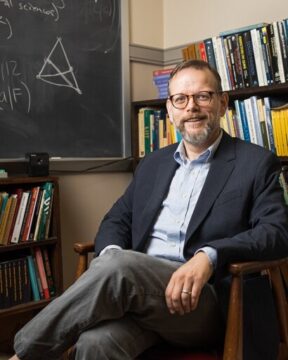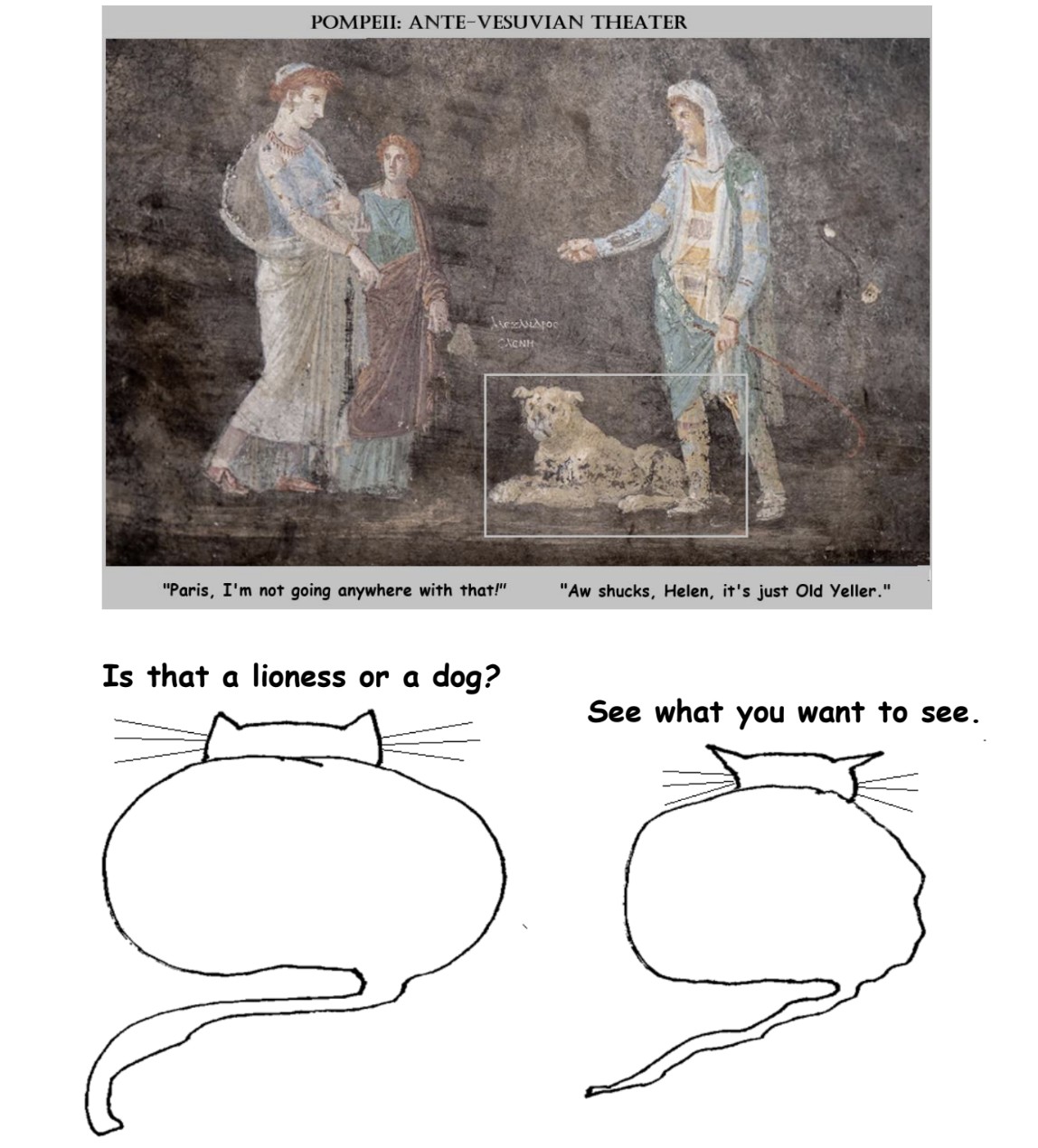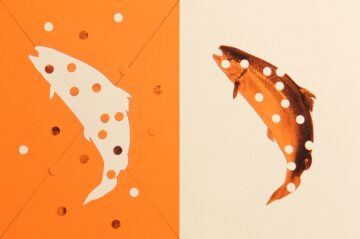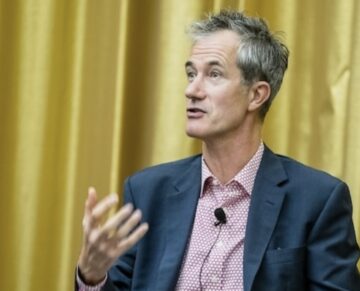Tuesday Poem
What He Thought
…………. —an excerpt
. . . we sat and chatted, sat and chewed,
till, sensible it was our last
big chance to be poetic, make
our mark, one of us asked
………………………………….. “What’s poetry?
Is it the fruits and vegetables and
marketplace of Campo dei Fiori, or
the statue there?” Because I was
the glib one, I identified the answer
instantly, I didn’t have to think—“The truth
is both, it’s both,” I blurted out. But that
was easy. That was the easiest to say. What followed
taught me something about difficulty,
for our underestimated host spoke out,
all of a sudden, with rising passion, and he said:
The statue represents Giordano Bruno,
brought to be burned in the public square
because of his offense against
authority, which is to say
the Church. His crime was his belief
the universe does not revolve around
the human being: God is no
fixed point or central government, but rather is
poured in waves through all things. All things
move. “If God is not the soul itself, He is
The soul of the soul of the world.” Such was
his heresy. The day they brought him
forth to die, they feared he might
incite the crowd (the man was famous
for his eloquence). And so his captors
placed upon his face
an iron mask, in which
he could not speak. That’s
how they burned him. That is how
he died: without a word, in front
of everyone.
………………. And poetry—
………………………………….. (we’d all
put down our forks by now, to listen to
the man in gray; he went on
softly)—
……………………… poetry is what
he thought, but did not say.
by Heather McHugh
from Poetry 180
Random House 2003
Thirteen Ways Of Looking At A Black Man
Henry Louis Gates, Jr at The New Yorker (from 1995):
 The two weeks spanning the O. J. Simpson verdict and Louis Farrakhan’s Million Man March on Washington were a good time for connoisseurs of racial paranoia. As blacks exulted at Simpson’s acquittal, horrified whites had a fleeting sense that this race thing was knottier than they’d ever supposed—that, when all the pieties were cleared away, blacks really were strangers in their midst. (The unspoken sentiment: And I thought I knew these people.) There was the faintest tincture of the Southern slaveowner’s disquiet in the aftermath of the bloody slave revolt led by Nat Turner—when the gentleman farmer was left to wonder which of his smiling, servile retainers would have slit his throat if the rebellion had spread as was intended, like fire on parched thatch. In the day or so following the verdict, young urban professionals took note of a slight froideur between themselves and their nannies and babysitters—the awkwardness of an unbroached subject. Rita Dove, who recently completed a term as the United States Poet Laureate, and who believes that Simpson was guilty, found it “appalling that white people were so outraged—more appalling than the decision as to whether he was guilty or not.” Of course, it’s possible to overstate the tensions. Marsalis invokes the example of team sports, saying, “You want your side to win, whatever the side is going to be. And the thing is, we’re still at a point in our national history where we look at each other as sides.”
The two weeks spanning the O. J. Simpson verdict and Louis Farrakhan’s Million Man March on Washington were a good time for connoisseurs of racial paranoia. As blacks exulted at Simpson’s acquittal, horrified whites had a fleeting sense that this race thing was knottier than they’d ever supposed—that, when all the pieties were cleared away, blacks really were strangers in their midst. (The unspoken sentiment: And I thought I knew these people.) There was the faintest tincture of the Southern slaveowner’s disquiet in the aftermath of the bloody slave revolt led by Nat Turner—when the gentleman farmer was left to wonder which of his smiling, servile retainers would have slit his throat if the rebellion had spread as was intended, like fire on parched thatch. In the day or so following the verdict, young urban professionals took note of a slight froideur between themselves and their nannies and babysitters—the awkwardness of an unbroached subject. Rita Dove, who recently completed a term as the United States Poet Laureate, and who believes that Simpson was guilty, found it “appalling that white people were so outraged—more appalling than the decision as to whether he was guilty or not.” Of course, it’s possible to overstate the tensions. Marsalis invokes the example of team sports, saying, “You want your side to win, whatever the side is going to be. And the thing is, we’re still at a point in our national history where we look at each other as sides.”
more here.
Monday, April 15, 2024
Joseph H. Shieber, RIP
NOTE: For the past six years, Joseph Shieber was a much-valued contributor here at 3QD. He wrote 73 essays for us which can be seen here. We are all saddened by his loss and wish to express our sympathy to his wife, Lesa, and his children, Samuel and Noa. This obituary is taken from here.
 Joseph H. Shieber, April 7, 2024 of Wallingford, PA. Beloved husband of Lesa Shieber; proud father of Samuel and Noa; loving son of Benjamin and Eileen Shieber; devoted brother of William (Rebecca) Shieber and Jonathan (Kathleen) Shieber.
Joseph H. Shieber, April 7, 2024 of Wallingford, PA. Beloved husband of Lesa Shieber; proud father of Samuel and Noa; loving son of Benjamin and Eileen Shieber; devoted brother of William (Rebecca) Shieber and Jonathan (Kathleen) Shieber.
Joseph (“Joe”) Shieber was a loving husband and father, beloved son and brother, and respected Professor at Lafayette College. But that brief description does not encompass Joe’s remarkable impact on everyone he met.
Joe grew up in Baton Rouge, Louisiana, within walking distance of LSU, where his dad, Professor Ben Shieber taught and his mom, Eileen Shieber, received her graduate degree. From the start, Joe was blessed with great intelligence, an even temperament, and a profound gift for friendship and love. Joe went to Yale College where he received his B.A. in Literature, while participating in the singing groups Tangled Up In Blue and the Whiffenpoofs. He then studied at the Free University in Berlin, where he received two Masters Degrees, in Mathematics and Philosophy, and Brown University, where he received a Ph.D. in Philosophy. His Brown graduation was blessed with a driving rain, and the Ph.D. recipients were forced to sit outside while an appropriate worthy person droned on with thoughts on how to lead a good life. Perhaps it was this experience which led to Joe’s research on effective (or ineffective) communications.
Joe then went off to teach Philosophy at Lafayette College. At the time of his death, Joe was the James Renwick Hogg Professor of Mental and Moral Philosophy, which is quite the mouthful. Joe was a beloved teacher and colleague. He was, by his fellow faculty’s account, the smartest and best-read philosopher in a department made up of smart and well-read philosophers. Philosophers are conditioned to make the first statement, the fastest statement, and the best statement. Joe was not that way. Joe always waited, giving respect to those who were speaking. He was decent, and his intellectual generosity was “really honest.” Read more »
How do you solve a problem like nukes?
by Ashutosh Jogalekar
 As the saying goes, if you believe only fascists guard borders, then you will ensure that only fascists will guard borders. The same principle applies to scientists working on nuclear weapons. If you believe that only Strangelovian warmongers work on nuclear weapons, you run the risk of ensuring that only such characters will do it.
As the saying goes, if you believe only fascists guard borders, then you will ensure that only fascists will guard borders. The same principle applies to scientists working on nuclear weapons. If you believe that only Strangelovian warmongers work on nuclear weapons, you run the risk of ensuring that only such characters will do it.
We can therefore be thankful that there are sane scientists with diverse opinions about America’s nuclear weapons who work on these fiendish creations. And we can be doubly thankful that journalist and writer Sarah Scoles has taken the trouble to write about them in her book, “Countdown”. Scoles has an eye for the interesting, the droll and the ironic. She tours the sites where nuclear weapons have been developed and maintained – most notably America’s national labs – and spends ample time with a handful of scientists and engineers who work with them. She talks at length to these patriotic men and women and paints a revealing portrait of people who, apart from their work, are just…well, people. They have families and hobbies and take their kids to soccer and swim practice. They love to chat up their neighbors and drink wine with them. They love to argue and are well aware of both sides of the debate. They are smart and highly skilled at their trades. Most importantly, while they would like to see a world free of nuclear weapons, they know that until that happens, deterrence is our best bet to keep the peace. They have taken it upon themselves to shoulder that grim responsibility. We should be glad that America’s nuclear weapons are in such safe hands.
But deterrence only works when its reliable. That is where the crux of the problem, and the main narrative of Scoles’s book, lies. You can only deter an adversary if you and the adversary believe that the weapons you are using to deter them work and are foolproof. You can only ensure the workings of a weapon if you test it on a regular basis. And since 1992 after the Cold War ended, the United States has not done any full-scale tests of a nuclear weapon. Doing such tests would be a major destabilizing move against Russia and China, still our most important adversaries when it comes to nuclear weapons. But not doing tests risks reducing the reliability of our nuclear weapons and undermines the very idea of deterrence. Therein lies the dilemma. Read more »
Farewell to a Songbird
by David Greer
I used to visit our airport on Vancouver Island not to catch a flight but to hear the skylarks. I stood in the parking lot and looked up. The stares from passengers arriving and departing seemed a small price to pay for the reward of listening to the endless birdsong spilling from the sky above the terminal.

The Eurasian skylarks were all but invisible, hovering two or three hundred feet above me, but I was familiar with their routine. Male skylarks begin their song flight with a rapid ascendance to hovering altitude, where they deliver their unbroken melodious stream, lasting up to 20 minutes. The longer and more complicated the song, the greater the likelihood of impressing a potential mate. The grassy fields around the runways provided ideal nesting sites for one of the last remaining skylark populations in North America. Fortunately, whenever I visited, the airport sky seemed always to overflow with skylark song, albeit to an intermittent accompaniment of airplane engines.
Eurasian skylarks were introduced to several American states in the nineteenth century by European immigrants nostalgic for the birds of home. A further introduction to Vancouver Island in 1903 was sufficiently successful that the local skylark population had grown to more than a thousand by the early 1960s.
Although only the male skylarks engage in the aerial opera, the long-standing belief that courtship songs are primarily the province of male birds has been well and truly shattered. That theory likely arose from the fact that early naturalists primarily made their observations in temperate zones where male birds play a larger role in birdsong. But the majority of songbird species are tropical (unsurprising, given that birds evolved in the general vicinity of Australia), and a 2014 study of almost all songbird families demonstrated that female song not only occurs in more than two-thirds of those species but also may be just as long and complex as male song. Read more »
Monday Poem
Replacing the Gates
If I’d broken the laws of light—
if I’d been caught by a black hole
and sent to prism,
would you visit me with spectral frequency
and split waves with me?
Would you help cleave white
into colors and set them free
to carom off of everything in sight
replacing the gates of hate
with rainbows?
by Jim Culleny
Dream of Money
by Tim Sommers

The fella says, we must never forget that we are human. And as humans we must dream. And when we dream, we dream of money. —David Mamet/The Spanish Prisoner (1998)
Long after Jesus held up a coin with Caesar’s picture on it and wisely counseled giving back to Caesar what, very obviously, was Caesar’s (‘Didn’t you see the picture?’), Adam Smith tried to tell us that money was not invented by governments. Money, and economic life entire, come from “a certain propensity in human nature,” he says, “the propensity to truck, barter, and exchange one thing for another.” Smith gives a detailed account of how such barter might arise in a group of shepherds or hunters. He does not pretend that this is an actual group of which he has actual knowledge. But what genre of story is this then?
Although many economists have told the “money comes from barter” story as nonfiction, contemporary economics textbooks tell it neither as fact nor fiction, but as a hypothetical. To see the benefits of money, one textbook advises, “imagine a barter economy.” “In a complex society with many goods,” says another, money replaces barter, since “barter exchanges involve an intolerable amount of effort.” More poetically, one textbook asks us to imagine that we “have roosters, but…want roses.”
The trouble is, as anthropologist Caroline Humphrey points out, “No example of a barter economy, pure and simple, has ever been described, let alone the emergence from it of money; all available ethnography suggests that there never has been such a thing.” Never?
Barter societies, where they exist at any scale, are what happens (initially, briefly) to societies that once used money after their central government collapses. So, while economists would have you believe that barter initially arises from “a certain propensity in human nature,” but that, given barter’s intolerable complexity, barter gives rise naturally to money, and that the use of money leads to credit and debt, David Graber argues that, basically, the opposite is true. Read more »
Overkill: The Increase in Extremely Violent Homicides
by Steven Gimbel and Gwydion Suilebhan
 A new study has revealed a troubling development in the state of Maryland: while murder rates fluctuated between 2005 and 2017—first trending downward, then increasing for a few years—the homicides recorded during that period have grown steadily more violent the entire time.
A new study has revealed a troubling development in the state of Maryland: while murder rates fluctuated between 2005 and 2017—first trending downward, then increasing for a few years—the homicides recorded during that period have grown steadily more violent the entire time.
According to “Increasing Injury Intensity among 6,500 Violent Deaths in the State of Maryland,” which is forthcoming in the Journal of the American College of Surgeons, researchers examined the intensity of deadly incidents over a 13-year period. Intensity was measured by the number of gunshots, stab wounds, and fractures exhibited by victims. Across all three causes of death, while the rate of homicides varied during the period, the percentage of high-violence crimes consistently increased.
Conducting the study was easier in Maryland than it might have been in other states. Maryland is unusual in that its Chief Medical Examiner is required to report on all murders, suicides, and unusual deaths, which means that researchers had access to a broad-based data set. State policy meant that researchers had access to information about victims who died under medical care and those who died at the scene of the crime. The state’s data set was geographically comprehensive, too, including cases from Baltimore’s urban center, the suburban areas around Baltimore and Washington, DC, and the rural areas in the eastern and western parts of the state. Read more »
This Mediated World
by Christopher Horner
Immediacy itself is essentially mediated —Hegel

Look at that desk in front of you right here, now. Isn’t it just there, a bare existence, a simple immediate thing right in front of you? The senses register its presence. This, at least, is a bare fact that you know.
But look again at the desk in front of you. What is it you are aware of? A desk: not a carpet or a parrot, its colour (brown), its shape (rectangular), all that is that negates what might have been (it isn’t grey, it isn’t circular, etc). Your awareness of the desk is mediated by concepts and you, a language user, can only make sense of the thing through those concepts, the universal terms that enable you to pick out this thing here, now. And you are aware of it now as you were 5 minutes ago, although the light has changed and you, a namable person, not a disembodied spirit, have shifted your position on your chair to look back at the clock on the wall. Time, place, objects: everything is mediated: that is, nothing is simply ‘there’ in splendid isolation to be passively registered by your senses.[1]
 Consider again the wooden desk. It was once part of a tree, like the ones outside your window. It became a bit of furniture though a long process of growth, cutting, shaping buying and selling until it got to you. You sit before it as it has a use – a use value – but it was made, not to give you a platform for your coffee or laptop, but in order to make a profit: it has an exchange value, and so had a price. It is a commodity, the product of an entire economic system, capitalism, that got it to you. Someone laboured to make it and someone else, probably, profited by its sale. It has a history, a backstory.
Consider again the wooden desk. It was once part of a tree, like the ones outside your window. It became a bit of furniture though a long process of growth, cutting, shaping buying and selling until it got to you. You sit before it as it has a use – a use value – but it was made, not to give you a platform for your coffee or laptop, but in order to make a profit: it has an exchange value, and so had a price. It is a commodity, the product of an entire economic system, capitalism, that got it to you. Someone laboured to make it and someone else, probably, profited by its sale. It has a history, a backstory.
 All of this is the case, but none of it simply appears to the senses. Capitalism itself isn’t a thing, but that doesn’t make it less real. The idea that all that there really is amounts to things you can bump into or drop on your foot is the ‘common sense’ that operates as the ideology of everyday life: “this is your world and these are the facts”. But really, nothing is like that: there are no isolated facts, but rather a complex, twisted web of mediations: connections and negations that transform over time.
All of this is the case, but none of it simply appears to the senses. Capitalism itself isn’t a thing, but that doesn’t make it less real. The idea that all that there really is amounts to things you can bump into or drop on your foot is the ‘common sense’ that operates as the ideology of everyday life: “this is your world and these are the facts”. But really, nothing is like that: there are no isolated facts, but rather a complex, twisted web of mediations: connections and negations that transform over time.
This doesn’t mean that the way things show up for us is somehow false, an illusion that masks a hidden essence. The essence of a thing is reflected in the way it appears, in the connections and negations with everything else, and in the way in which it develops over time. Read more »
Catspeak
by Brooks Riley

No Shrinking Violeta: Isabel Allende on a Disastrous Century of Pandemics, Power, and Precarity
by Claire Chambers
 The Chilean-American author Isabel Allende published her twenty-first Spanish-language novel Violeta in 2022, with an English translation by Frances Riddle appearing the same year. This historical novel is affecting and witty, as Allende paints a vivid picture of rural and urban communities in an unnamed country which clearly recalls Chile. Riddle’s translation is clean and unfussy, making the book an easy read and seemingly conveying the original’s musicality. At times the text’s straightforward Bildungsroman path and revolving door of characters can make the narrative feel superficial. Although the novel occasionally suffers from a hurried pace, it compensates with original, unsentimental observations about social issues from an insider’s perspective.
The Chilean-American author Isabel Allende published her twenty-first Spanish-language novel Violeta in 2022, with an English translation by Frances Riddle appearing the same year. This historical novel is affecting and witty, as Allende paints a vivid picture of rural and urban communities in an unnamed country which clearly recalls Chile. Riddle’s translation is clean and unfussy, making the book an easy read and seemingly conveying the original’s musicality. At times the text’s straightforward Bildungsroman path and revolving door of characters can make the narrative feel superficial. Although the novel occasionally suffers from a hurried pace, it compensates with original, unsentimental observations about social issues from an insider’s perspective.
Within Latin American and decolonial literary studies, opinions about Allende are mixed, influenced in part by prevailing elitism and misogyny. Her 1982 novel La casa de los espíritus (The House of the Spirits) is widely considered Allende’s magnum opus. Even so, aspersions were soon made that the text was derivative of the Colombian novelist Gabriel García Márquez’s One Hundred Years of Solitude. Defenders argued she was engaging in homage, parody, and valid intertextuality in this magical realist work. Some critics dismiss her work as ‘airport lit’ or middlebrow fiction, lambasting its love stories and the author’s perceived recycling of her own and others’ ideas. She has also been depicted as ‘suspiciously bourgeois’ when compared to more overtly political writers. However, many if not most onlookers regard her as a talented and socially committed feminist writer.
Despite its flaws, Violeta is an enlightening read that aligns with my current teaching and book project Decolonizing Disease: Pandemics, Public Health, and Decoronial Writing. Although I focus solely on public health crises, the reality is that they are fused together with other disasters. That is what this novel reveals quite brilliantly. Read more »
A Baseball Melancholia
by Nils Peterson
I
This is how it felt.
Yankee Stadium Gone – Impossible. It’s like going to your old hometown and finding your house – No! the neighborhood tarmacked over. Yes, we live in the world of Heraclitus, “Everything flows and nothing abides; everything gives way and nothing stays fixed.” Flux is all.
The first time I went to Yankee Stadium, I lived in New Jersey and I went with Bunny Reid, a neighborhood friend who lived in a strange house filled mostly with aunts. It had a big, big yard, and in the fall we’d play football on the long open side yard. In the spring and summer we’d play catch with mitts too big for our hands or we’d throw a pink rubber ball against the side of a garage that had been a carriage house keeping careful track of balls and strikes. We were Yankee fans. His father wasn’t around much. I think he had something to do with the railroad, but he took us to see a real game at Yankee Stadium.
I guess we drove up there through the Tunnel or over the George Washington Bridge, but memory isn’t certain here, because it was wartime and gas rationed and difficult to find, the speed limit 45 as I recall. I think I would remember train or bus. The great players were off playing for Uncle Sam, so likely this is 1944 or maybe ’45 before VE and VJ Days. However we got there, I was thrilled at being in that marvelous, seemingly eternal Coliseum, the House That Ruth Built.
Bunny’s father got the tickets, gave me mine – and, all of a sudden they were gone, Bunny and his father were nowhere in sight. There I was, 10 years old, 11 at most, 50 miles from home, maybe 50 cents in my pocket for a hot dog and a drink. Maybe there was a moment of panic. Maybe not. I took my ticket, asked an usher where my seat was, and went to it. Read more »
Monday Photo
Taste, Organic Unity, and Creative Tasting
by Dwight Furrow
 Is there such a thing as tasting expertise that, if mastered, would help us enjoy a dish or a meal? It isn’t obvious such expertise has been identified.
Is there such a thing as tasting expertise that, if mastered, would help us enjoy a dish or a meal? It isn’t obvious such expertise has been identified.
The most prominent model of tasting expertise is derived from the practice of wine tasting and has been extended to the assessment of cheese, coffee, chocolate, beer, spirits, and a variety of other products. These products are notably complex and exhibit flavors and aromas that are difficult to detect yet important to the quality of the product. The aim of expert tasters is to break the taste object into its component flavors, aromas, and textures so each element can be clearly identified and named with the help of flavor wheels that sort these flavors into categories. The expertise required for such analytic tasting is one of discernment—identifying hidden aromas or flavors that untrained tasters might miss. Analytic tasting is useful for assessing products, identifying the origin of a product, or training one’s ability to discern flavors. However, analytic tasting pays only cursory attention to how flavors and textures are then knit together to form a coherent whole.
By contrast, typical diners when enjoying a dish or meal are less interested in identifying hidden aromas or flavors and more interested in whether the elements fit together coherently. The enjoyment of complex dishes, as well as several dishes served as part of a meal, involves tasting relations between multiple taste objects rather than discrete, individual taste objects. But what kind of relations are we tasting? Part/whole relations would be the obvious type. For a dish or meal to be aesthetically successful, ingredients and flavors must be perceived as being fully integrated parts of a coherent whole.
In aesthetics, this relationship between whole and parts has traditionally been understood in terms of organic unity. Read more »
Review: Breaking the Two-Party Doom Loop
by Jerry Cayford
It’s a book about how our political system fell into this downward spiral—a doom loop of toxic politics. It’s a story that requires thinking big—about the nature of political conflict, about broad changes in American society over many decades, and, most of all, about the failures of our political institutions. (2)
Where to begin fixing our dysfunctional society is about as contentious a question as there is. Lee Drutman’s 2020 book Breaking the Two-Party Doom Loop: The Case for Multiparty Democracy in America confronts it head-on. Chapter 1, “What the Framers Got Right and What They Got Wrong,” goes straight to the heart of the matter: what the Founding Fathers got wrong is political parties. They understood the threat of tyranny that parties (“factions”) posed, but they misunderstood the benefits and inevitability of parties. They structured our government to discourage parties, instead of to accommodate them. As Drutman explains, those structural weaknesses have finally caught up with us in today’s toxic partisanship.
Like the Founders, Drutman gets important things right and wrong. He says, “At its core, my argument can be distilled into two words: institutions matter” (4). Political parties are the institutions he defends and criticizes. What we need parties to provide are substantive choices, not coercive conformity or destabilizing toxicity. This focus on parties is one of the many, many things Drutman gets right in his well-written, informative, and important book. When he turns from diagnosis to solution, though, he gets one big thing wrong. Read more »
Sunday, April 14, 2024
Can Certain Foods Really Stave Off Dementia?
Amelia Nierenberg in The New York Times:
 Walnuts can improve cognitive function. Blueberries can boost memory. Fish oil supplements can lower your risk of Alzheimer’s disease.
Walnuts can improve cognitive function. Blueberries can boost memory. Fish oil supplements can lower your risk of Alzheimer’s disease.
You may have noticed these buzzy “brain food” claims scattered across online health articles and social media feeds. But can certain foods or diets really stave off or prevent dementia? Experts say that while nutrition studies are notoriously challenging to carry out, there is a compelling and ever-growing body of research that does suggest that some foods and diets may offer real benefits to an aging brain. So we spoke with two dozen researchers and pored over the research to better understand the links between diet and dementia. Scientists don’t yet know for certain what causes Alzheimer’s disease, the most common form of dementia. And there is currently no medication that can reverse it, said Dr. Uma Naidoo, the director of nutritional and metabolic psychiatry at Massachusetts General Hospital and the author of “This Is Your Brain on Food.”
More here.
Lucy’s World
Ann Gibbons in Science:
 Zeresenay Alemseged doesn’t remember the 1974 discovery of the famous fossil Lucy at Hadar in Ethiopia, because he was 5 years old, living 600 kilometers away in Axum. Later he saw Lucy’s name on cafes and taxis, but he knew little about her until he became a geologist working at the National Museum of Ethiopia. Then, she changed his life. In 2000, Alemseged was swept into Lucy’s orbit: He discovered “Lucy’s child,” a partial skeleton of a toddler of her species, at Dikika, 10 kilometers from Hadar. In 2015, by then a well-known scientist, he had the honor of showing Lucy to then-President Barack Obama before a state dinner at Ethiopia’s National Palace. Alemseged allowed Obama to touch the prized skeleton, telling him the fossil shows Ethiopia is the birthplace of humankind and that “every single person” on the planet shares an origin in Africa. “Including Donald Trump,” Alemseged joked to Obama.
Zeresenay Alemseged doesn’t remember the 1974 discovery of the famous fossil Lucy at Hadar in Ethiopia, because he was 5 years old, living 600 kilometers away in Axum. Later he saw Lucy’s name on cafes and taxis, but he knew little about her until he became a geologist working at the National Museum of Ethiopia. Then, she changed his life. In 2000, Alemseged was swept into Lucy’s orbit: He discovered “Lucy’s child,” a partial skeleton of a toddler of her species, at Dikika, 10 kilometers from Hadar. In 2015, by then a well-known scientist, he had the honor of showing Lucy to then-President Barack Obama before a state dinner at Ethiopia’s National Palace. Alemseged allowed Obama to touch the prized skeleton, telling him the fossil shows Ethiopia is the birthplace of humankind and that “every single person” on the planet shares an origin in Africa. “Including Donald Trump,” Alemseged joked to Obama.
Fifty years after her discovery, “Lucy is an icon,” says Alemseged, now a paleoanthropologist at the University of Chicago.
More here.
Busting Genre, in Style: Geoff Dyer
George Makari at Literary Hub:
George Makari: I heard you say in an interview that as you’re starting to think about writing a book, you write a note to yourself, saying, “Write a book that no one else could write.”
 Geoff Dyer: Yeah, it’s a little piece of self-encouragement. Because, you know, sometimes I’m sort of worried about my take on a given subject. Do I know enough about it? Take for example, my history of photography called The Ongoing Moment. I wrote that book because I wanted to find out about the history of photography. I wrote the book for the same reason that readers might later go to it.
Geoff Dyer: Yeah, it’s a little piece of self-encouragement. Because, you know, sometimes I’m sort of worried about my take on a given subject. Do I know enough about it? Take for example, my history of photography called The Ongoing Moment. I wrote that book because I wanted to find out about the history of photography. I wrote the book for the same reason that readers might later go to it.
I think one of the features of nonfiction today is that, to a degree, a book could be written by anyone possessed of a certain level of knowledge. The area of expertise might change, but quite often, there’s nothing particularly distinct about the writing or the thought. With my books, for good or ill, they could only be written by me.
More here.
Viruses Finally Reveal Their Complex Social Life
Carl Zimmer in Quanta:
 Granted, the social lives of viruses aren’t quite like those of other species. Viruses don’t post selfies to social media, volunteer at food banks or commit identity theft like humans do. They don’t fight with allies to dominate a troop like baboons; they don’t collect nectar to feed their queen like honeybees; they don’t even congeal into slimy mats for their common defense like some bacteria do. Nevertheless, sociovirologists believe that viruses do cheat, cooperate and interact in other ways with their fellow viruses.
Granted, the social lives of viruses aren’t quite like those of other species. Viruses don’t post selfies to social media, volunteer at food banks or commit identity theft like humans do. They don’t fight with allies to dominate a troop like baboons; they don’t collect nectar to feed their queen like honeybees; they don’t even congeal into slimy mats for their common defense like some bacteria do. Nevertheless, sociovirologists believe that viruses do cheat, cooperate and interact in other ways with their fellow viruses.
The field of sociovirology is still young and small. The first conference dedicated to the social life of viruses took place in 2022, and the second will take place this June. A grand total of 50 people will be in attendance. Still, sociovirologists argue that the implications of their new field could be profound.
More here.

